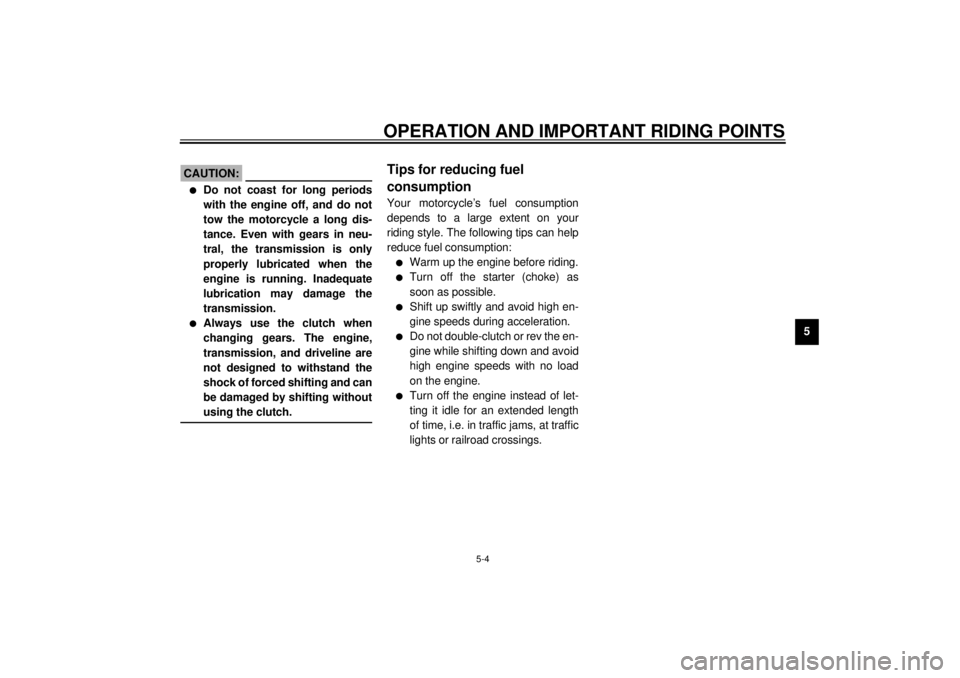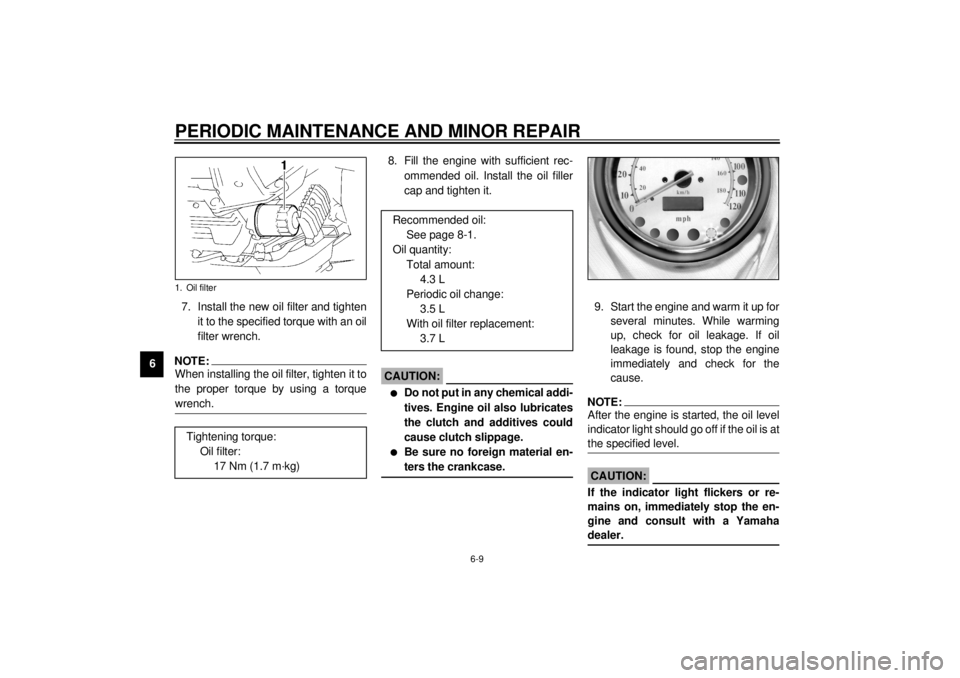Page 36 of 91

OPERATION AND IMPORTANT RIDING POINTS
5-2
5 1. Turn the fuel cock to “ON”.
2. Turn the main switch to “ON” and
the engine stop switch to “ ”.
EC000037
CAUTION:@ If the fuel level indicator light comes
on, check the fuel level. If neces-
sary, add fuel. @3. Shift transmission into neutral.NOTE:@ When the transmission is in neutral, the
neutral indicator light should be on. If
the light does not come on, ask a
Yamaha dealer to inspect it. @
4. Turn on the starter (choke) and
completely close the throttle grip.
5. Start the engine by pushing the
starter switch.NOTE:@ If the engine fails to start, release the
starter switch, wait a few seconds, then
try again. Each attempt should be as
short as possible to preserve the bat-
tery. Do not crank the engine more
than 10 seconds on any one attempt. @
ECA00003
CAUTION:@ The oil level indicator light and en-
gine overheat indicator light should
come on when the start switch is
pushed and should go off when the
start switch is released. If the oil lev-
el indicator light flickers or remains
on, immediately stop the engine and
check the engine oil level and for oil
leakage. If necessary, fill the engine
with oil and check to see that the oil
level indicator light goes off. If not,
consult a Yamaha dealer. @
E_4YP_Operation.fm Page 2 Wednesday, October 6, 1999 10:05 AM
Page 37 of 91
OPERATION AND IMPORTANT RIDING POINTS
5-3
56. After starting the engine, move the
starter (choke) to the halfway posi-
tion.
NOTE:@ For maximum engine life, never accel-
erate hard with a cold engine! @7. After the engine is warm, turn off
the starter (choke) completely.NOTE:@ The engine is warm when it responds
normally to the throttle with the starter
(choke) turned off. @
EAU01258
Starting a warm engineThe starter (choke) is not required
when the engine is warm.
EC000046
CAUTION:@ See the “Engine break-in” section
prior to operating the motorcycle for
the first time. @
EAU00423
ShiftingThe transmission lets you control the
amount of power you have available at
a given speed for starting, accelerating,
climbing hills, etc. The use of the shift
pedal is shown in the illustration.
To shift into neutral, depress the shift
pedal repeatedly until it reaches the
end of its travel, then raise the pedal
slightly.
E_4YP_Operation.fm Page 3 Wednesday, October 6, 1999 10:05 AM
Page 38 of 91

OPERATION AND IMPORTANT RIDING POINTS
5-4
5
EC000048
CAUTION:@ l
Do not coast for long periods
with the engine off, and do not
tow the motorcycle a long dis-
tance. Even with gears in neu-
tral, the transmission is only
properly lubricated when the
engine is running. Inadequate
lubrication may damage the
transmission.
l
Always use the clutch when
changing gears. The engine,
transmission, and driveline are
not designed to withstand the
shock of forced shifting and can
be damaged by shifting without
using the clutch.
@
EAU00424
Tips for reducing fuel
consumptionYour motorcycle’s fuel consumption
depends to a large extent on your
riding style. The following tips can help
reduce fuel consumption:l
Warm up the engine before riding.
l
Turn off the starter (choke) as
soon as possible.
l
Shift up swiftly and avoid high en-
gine speeds during acceleration.
l
Do not double-clutch or rev the en-
gine while shifting down and avoid
high engine speeds with no load
on the engine.
l
Turn off the engine instead of let-
ting it idle for an extended length
of time, i.e. in traffic jams, at traffic
lights or railroad crossings.
E_4YP_Operation.fm Page 4 Wednesday, October 6, 1999 10:05 AM
Page 42 of 91

6
PERIODIC MAINTENANCE AND MINOR REPAIR
Tool kit................................................................... 6-1
Periodic maintenance and lubrication ................... 6-3
Spark plugs........................................................... 6-6
Engine oil .............................................................. 6-7
Final gear oil ....................................................... 6-10
Coolant ............................................................... 6-10
Carburetor adjustment ........................................ 6-11
Idle speed adjustment ........................................ 6-11
Throttle cable free play inspection ...................... 6-12
Valve clearance adjustment ................................ 6-12
Tires .................................................................... 6-13
Wheels ................................................................ 6-15
Clutch lever free play adjustment........................ 6-16
Front brake lever free play adjustment ................ 6-17
Rear brake pedal height adjustment ................... 6-17Brake light switch adjustment ............................. 6-18
Checking the front and rear brake pads ............. 6-19
Inspecting the brake fluid level ........................... 6-19
Brake fluid replacement ..................................... 6-21
Brake and shift pedal lubrication ........................ 6-21
Brake and clutch lever lubrication ...................... 6-22
Sidestand lubrication.......................................... 6-22
Front fork inspection ........................................... 6-23
Battery................................................................ 6-23
Fuse replacement .............................................. 6-25
Headlight bulb replacement ............................... 6-27
Turn signal and taillight bulb replacement .......... 6-28
Troubleshooting .................................................. 6-28
Troubleshooting chart ......................................... 6-29
E_4YP_PeriodicTOC.fm Page 1 Wednesday, October 6, 1999 10:05 AM
Page 48 of 91

PERIODIC MAINTENANCE AND MINOR REPAIR
6-6
6
EAU01485
Spark plugsRemoval
1. Remove the spark plug cap.2. Use the spark plug wrench in the
tool kit to remove the spark plug as
shown.
Inspection
The spark plug is an important engine
component and is easy to inspect. The
condition of the spark plug can indicate
the condition of the engine. Normally,
all spark plugs from the same engine
should have the same color on the
white insulator around the center elec-
trode. The ideal color at this point is a
medium-to-light tan color for a motor-
cycle that is being ridden normally. If
one spark plug shows a distinctly differ-ent color, there could be something
wrong with the engine. Do not attempt
to diagnose such problems yourself. In-
stead, take the motorcycle to a
Yamaha dealer. You should periodical-
ly remove and inspect the spark plugs
because heat and deposits will cause
any spark plug to slowly break down
and erode. If electrode erosion be-
comes excessive, or if carbon and oth-
er deposits are excessive, you should
replace the spark plug with the speci-
fied plug.1. Spark plug cap
1. Spark plug wrench
Specified spark plug:
DPR7EA-9/NGK or
X22EPR-U9/DENSO
E_4YP_Periodic.fm Page 6 Wednesday, October 6, 1999 10:05 AM
Page 49 of 91

PERIODIC MAINTENANCE AND MINOR REPAIR
6-7
6Installation
1. Measure the electrode gap with a
wire thickness gauge and, if nec-
essary, adjust the gap to specifica-
tion.
2. Clean the gasket surface. Wipe off
any grime from the threads.3. Install the spark plug and tighten it
to the specified torque.
NOTE:@ If a torque wrench is not available when
you are installing a spark plug, a good
estimate of the correct torque is 1/4 to
1/2 turn past finger tight. Have the
spark plug tightened to the specified
torque as soon as possible. @
EAU01703
Engine oilOil level inspection
1. Place the motorcycle on a level
place and hold it in an upright posi-
tion. Warm up the engine for seve-
ral minutes.NOTE:@ Be sure the motorcycle is positioned
straight up when checking the oil level.
A slight tilt toward the side can result in
false readings. @
a. Spark plug gapSpark plug gap:
0.8 ~ 0.9 mm
Tightening torque:
Spark plug:
17.5 Nm (1.75 m·kg)
1. Oil level window
2. Maximum level mark
3. Minimum level mark
E_4YP_Periodic.fm Page 7 Wednesday, October 6, 1999 10:05 AM
Page 50 of 91

PERIODIC MAINTENANCE AND MINOR REPAIR
6-8
6 2. Stop the engine and wait for a few
minutes. Check the oil level
through the level window located
at the lower part of the right side
crankcase cover.
NOTE:@ Wait a few minutes until the oil level
settles before checking. @3. The oil level should be between
the maximum and minimum
marks. If the level is low, fill the en-
gine with sufficient recommended
oil to reach the specified level.Engine oil and oil filter cartridge re-
placement
1. Warm up the engine for several
minutes.
2. Stop the engine. Place an oil pan
under the engine and remove the
oil filler cap.
3. Remove the drain bolt and drain
the oil.
4. Remove the oil filter by using an oil
filter wrench.
NOTE:@ An oil filter wrench is available at a
nearby Yamaha dealer. @
5. Reinstall the drain bolt and tighten
it to the specified torque.
6. Apply a light coat of engine oil to
the O-ring of new oil filter.NOTE:@ Make sure the O-ring is seated proper-
ly. @
1. Engine oil filler cap
1. Engine oil drain boltTightening torque:
Drain bolt:
43 Nm (4.3 m·kg)
E_4YP_Periodic.fm Page 8 Wednesday, October 6, 1999 10:05 AM
Page 51 of 91

PERIODIC MAINTENANCE AND MINOR REPAIR
6-9
67. Install the new oil filter and tighten
it to the specified torque with an oil
filter wrench.
NOTE:@ When installing the oil filter, tighten it to
the proper torque by using a torque
wrench. @
8. Fill the engine with sufficient rec-
ommended oil. Install the oil filler
cap and tighten it.
EC000066
CAUTION:@ l
Do not put in any chemical addi-
tives. Engine oil also lubricates
the clutch and additives could
cause clutch slippage.
l
Be sure no foreign material en-
ters the crankcase.
@
9. Start the engine and warm it up for
several minutes. While warming
up, check for oil leakage. If oil
leakage is found, stop the engine
immediately and check for the
cause. NOTE:After the engine is started, the oil level
indicator light should go off if the oil is at
the specified level.
EC000067
CAUTION:@ If the indicator light flickers or re-
mains on, immediately stop the en-
gine and consult with a Yamaha
dealer. @
1. Oil filterTightening torque:
Oil filter:
17 Nm (1.7 m·kg)
Recommended oil:
See page 8-1.
Oil quantity:
Total amount:
4.3 L
Periodic oil change:
3.5 L
With oil filter replacement:
3.7 L
E_4YP_Periodic.fm Page 9 Wednesday, October 6, 1999 10:05 AM